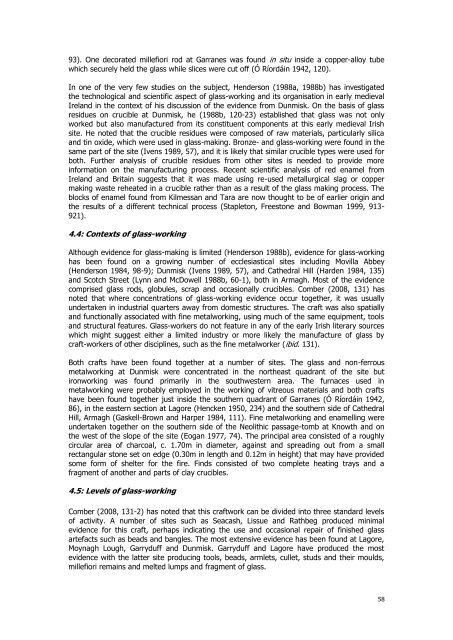EMAP_2012_Report_6_1.pdf (7.3 MB) - The Heritage Council
EMAP_2012_Report_6_1.pdf (7.3 MB) - The Heritage Council
EMAP_2012_Report_6_1.pdf (7.3 MB) - The Heritage Council
Create successful ePaper yourself
Turn your PDF publications into a flip-book with our unique Google optimized e-Paper software.
93). One decorated millefiori rod at Garranes was found in situ inside a copper-alloy tube<br />
which securely held the glass while slices were cut off (Ó Ríordáin 1942, 120).<br />
In one of the very few studies on the subject, Henderson (1988a, 1988b) has investigated<br />
the technological and scientific aspect of glass-working and its organisation in early medieval<br />
Ireland in the context of his discussion of the evidence from Dunmisk. On the basis of glass<br />
residues on crucible at Dunmisk, he (1988b, 120-23) established that glass was not only<br />
worked but also manufactured from its constituent components at this early medieval Irish<br />
site. He noted that the crucible residues were composed of raw materials, particularly silica<br />
and tin oxide, which were used in glass-making. Bronze- and glass-working were found in the<br />
same part of the site (Ivens 1989, 57), and it is likely that similar crucible types were used for<br />
both. Further analysis of crucible residues from other sites is needed to provide more<br />
information on the manufacturing process. Recent scientific analysis of red enamel from<br />
Ireland and Britain suggests that it was made using re-used metallurgical slag or copper<br />
making waste reheated in a crucible rather than as a result of the glass making process. <strong>The</strong><br />
blocks of enamel found from Kilmessan and Tara are now thought to be of earlier origin and<br />
the results of a different technical process (Stapleton, Freestone and Bowman 1999, 913-<br />
921).<br />
4.4: Contexts of glass-working<br />
Although evidence for glass-making is limited (Henderson 1988b), evidence for glass-working<br />
has been found on a growing number of ecclesiastical sites including Movilla Abbey<br />
(Henderson 1984, 98-9); Dunmisk (Ivens 1989, 57), and Cathedral Hill (Harden 1984, 135)<br />
and Scotch Street (Lynn and McDowell 1988b, 60-1), both in Armagh. Most of the evidence<br />
comprised glass rods, globules, scrap and occasionally crucibles. Comber (2008, 131) has<br />
noted that where concentrations of glass-working evidence occur together, it was usually<br />
undertaken in industrial quarters away from domestic structures. <strong>The</strong> craft was also spatially<br />
and functionally associated with fine metalworking, using much of the same equipment, tools<br />
and structural features. Glass-workers do not feature in any of the early Irish literary sources<br />
which might suggest either a limited industry or more likely the manufacture of glass by<br />
craft-workers of other disciplines, such as the fine metalworker (ibid. 131).<br />
Both crafts have been found together at a number of sites. <strong>The</strong> glass and non-ferrous<br />
metalworking at Dunmisk were concentrated in the northeast quadrant of the site but<br />
ironworking was found primarily in the southwestern area. <strong>The</strong> furnaces used in<br />
metalworking were probably employed in the working of vitreous materials and both crafts<br />
have been found together just inside the southern quadrant of Garranes (Ó Ríordáin 1942,<br />
86), in the eastern section at Lagore (Hencken 1950, 234) and the southern side of Cathedral<br />
Hill, Armagh (Gaskell-Brown and Harper 1984, 111). Fine metalworking and enamelling were<br />
undertaken together on the southern side of the Neolithic passage-tomb at Knowth and on<br />
the west of the slope of the site (Eogan 1977, 74). <strong>The</strong> principal area consisted of a roughly<br />
circular area of charcoal, c. 1.70m in diameter, against and spreading out from a small<br />
rectangular stone set on edge (0.30m in length and 0.12m in height) that may have provided<br />
some form of shelter for the fire. Finds consisted of two complete heating trays and a<br />
fragment of another and parts of clay crucibles.<br />
4.5: Levels of glass-working<br />
Comber (2008, 131-2) has noted that this craftwork can be divided into three standard levels<br />
of activity. A number of sites such as Seacash, Lissue and Rathbeg produced minimal<br />
evidence for this craft, perhaps indicating the use and occasional repair of finished glass<br />
artefacts such as beads and bangles. <strong>The</strong> most extensive evidence has been found at Lagore,<br />
Moynagh Lough, Garryduff and Dunmisk. Garryduff and Lagore have produced the most<br />
evidence with the latter site producing tools, beads, armlets, cullet, studs and their moulds,<br />
millefiori remains and melted lumps and fragment of glass.<br />
58
















